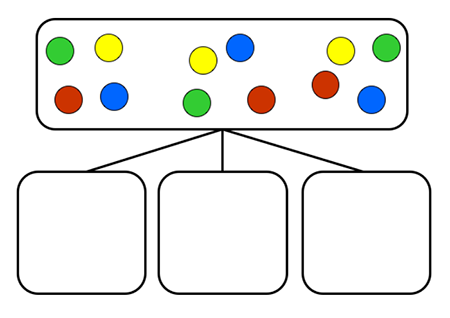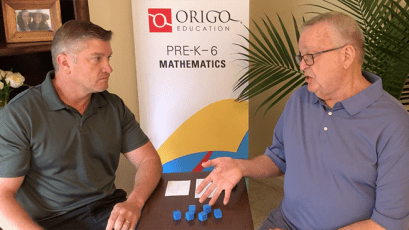Great Ideas
Visual Models in Mathematics: Using Graphic Organizers to Build Powerful Ideas (Part 4)
Graphic organizers build powerful ideas in the mathematics classroom
This article is the last of a four-part series on Visual Models in Mathematics. Read this post and check out the other articles in our series:
Part 1: Visual Models in Mathematics: The First Images (Part 1)
Part 2: Visual Models in Mathematics: The First Classroom Examples (Part 2)
Part 3: Visual Models in Mathematics: The Importance of a Number Line (Part 3)
Part 4: Graphic organizers for math that accelerate learning – this post
Math visual models such as counters, cubes, base-ten blocks, number lines, and a wide range of measurement and geometry materials are now common in elementary classrooms. When these materials are used, there is an assumption that students are seeing the concept or strategy that is the aim of the lesson.
Addition and Subtraction Math Graphic Organizers
When the idea of subtraction is taught, blocks are often used to act out the situation. For example, “Gerry has $8. She spends $2 to buy a gift. How much money does she now have in her wallet?” If the aim is to build understanding, we want students to see the total, the part that was spent, and the part that remains in the wallet. Using blocks, students usually begin with 8 blocks, remove 2 blocks and see the 6 blocks that remain.

If the blocks are carefully managed, students can see the total, part, part. However, the second picture above is the usual result and the students see only one number (6 blocks). The second picture does not clearly show a part of any total. In fact, the focus is solely on the answer rather than the overall idea of subtraction. All of the features linked to the idea of subtraction are easier to see if a simple graphic organizer, like a number mat, is used.

Students place 8 cubes on the number mat to show the starting amount. Like the first example, 2 cubes are removed. But, using a number mat, the 6 cubes are now on the “8 mat” which shows all of the key features for subtraction. The 8 dots on the mat is the total. The 6 cubes on the mat is a part. The 2 dots on the mat that are not covered form the other part. More importantly, the cubes on the mat make it much easier to see the connection between subtraction and addition. The “after” picture using the mat helps students see that 6 plus 2 is 8 as well as 8 subtract 2 is 6.
Multiplication and Division Math Graphic Organizers
A graphic organizer also helps to show the relationship between multiplication and division. The first everyday situations that are used to introduce multiplication usually involve equal groups. For example, “Jacque had 3 bags with 4 apples in each bag. If he tips the 3 bags into an empty basket, how many apples will be in the basket?” The answer can be obtained with counters without a graphic organizer, but with a “grouping mat” like the example pictured below, the before and after features help to show more about the concept. In particular, the answer in a multiplication situation is a total that is a result of joining several parts by pushing the counters down. The equivalent size of the smaller groups on the mat implies equality.

The most useful aspect of the grouping mat is the link to division when the “after” picture is rotated. Here, a total is shared among 3 groups (equally). In order to reinforce the link between the operations, these graphic organizers are often called “grouping and sharing” mats.

A grouping and sharing mat is a very useful tool for greater numbers. In the situation below, the quickest way to share (divide) is to start with the blocks in the hundreds place. For this example, students quickly see, that it is not possible to share and give a hundred to each of the 4 groups. So, it is necessary to regroup as shown in the second picture.

The process of division on the grouping and sharing mat helps students to visualize and describe a sequence of steps that is logical. In turn, this enables them to easily learn a mental or written method to divide.
Click on the ORIGO ONE video for more about how grouping and sharing mats can be used to model multiplication and division.
The discussion above suggests that cubes, counters, or base-ten blocks help students see ideas. But, a simple graphic organizer like a mat helps establish all the important features of an idea clearly and possibly faster than using manipulatives alone. When a graphic organizer is used, teachers should encourage students to describe actions, changes, and everything they see. This will accelerate their understanding.
Click on the video below for more about how graphic organizers support the operations.
Footnote: The number mats, as well as the grouping and sharing mats, are available in the ORIGO Number Cases at the grade level where they are appropriate. The number mats provided with this blog article can be used to act out addition and subtraction using either counters or cubes. (Click on the Resource Hub link below to download the support pages.)
The grouping and sharing mats can be used to act out multiplication and division using either cubes or base-ten blocks. Encourage students to select the starting amount, show it with the manipulative that is appropriate, and then act out the steps to find the number in each part/share.
Click HERE for the downloadable resources for this article!
About the Author
Calvin Irons cofounded ORIGO Education with James Burnett in 1995. Cal has been involved in mathematics education for over 50 years. He started his career as a specialist teacher of mathematics in Iowa after completing his BA and MA at the University of Northern Iowa in 1967. Dr. Irons received his PhD from Indiana University in 1975 (the dissertation topic was the teaching of division). In 1975, he accepted a position at the Queensland University of Technology, Brisbane, Australia where he has been involved in the teaching and the development of mathematics curricula for elementary schools. He has received outstanding achievement awards from the university for his work and in 2014 was the student’s nominee for University Outstanding Teacher of the Year from a university faculty of over 3000 professors. He is the author/co-author of over 600 books or articles including the award-winning ORIGO Stepping Stones mathematics program.
About ORIGO Education
ORIGO Education is dedicated to making learning meaningful, enjoyable and accessible for all students and their teachers with Pre-K and Elementary print and digital instructional materials, as well as professional learning for mathematics.
![]()




